Search -
Java Swing
Java Swing
Author:
The Swing classes eliminate Java's biggest weakness: its relatively primitive user interface toolkit. Swing provides many new components and containers that allow you to build sophisticated user interfaces, far beyond what was possible with AWT. The old components have been greatly improved, and there are many new components, like trees, tables,... more »
Author:
The Swing classes eliminate Java's biggest weakness: its relatively primitive user interface toolkit. Swing provides many new components and containers that allow you to build sophisticated user interfaces, far beyond what was possible with AWT. The old components have been greatly improved, and there are many new components, like trees, tables,... more »
ISBN-13: 9781565924550
ISBN-10: 156592455X
Publication Date: 9/1/1998
Pages: 1,252
Edition: 1
Rating: ?
ISBN-10: 156592455X
Publication Date: 9/1/1998
Pages: 1,252
Edition: 1
Rating: ?
0 stars, based on 0 rating
Genres:
- Computers & Technology >> Web Development & Design >> Programming
- Computers & Technology >> Programming >> Java
- Computers & Technology >> Programming Languages
- Computers & Technology >> Software





